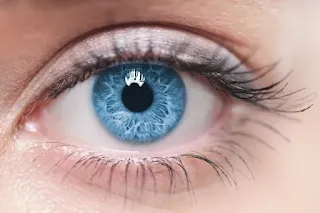The biological age of a person is different from the real age, and the secret is in the retina of the eye
In the new study, researchers turned to a deep learning technology that can predict a person's risk of death by analyzing the biological age of the retina.
Although the risk of disease and early death generally increases with age, this risk can vary slightly between individuals of the same age, and this difference can be explained by the "biological age" of a person, which - unlike chronological age - progresses at a different pace for each person, Depending on several health factors, according to the report published on Live Science on January 21.
Now, by examining the microvessels inside the eyes, doctors may one day be able to predict the risk of early death - according to a new study -. Previous studies have revealed different biomarkers in the body that may be able to determine a person's biological age, including specific genes Cognitive abilities, blood pressure and the immune system, according to a previous report by Live Science.
Previous research has shown that the retina, the light-sensitive layers of nerve tissue at the back of the eye, is a potential indicator of a person's biological age, as it can provide clues about disease risk.
"The retina provides a unique, accessible 'window' for assessing vascular and neurological diseases associated with an increased risk of death," the researchers said in the new study, published Jan. 18 in the British Journal of Ophthalmology.
Deep learning
In the new study, researchers turned to a deep learning technology that can predict a person's risk of death by analyzing the biological age of the retina - according to the press release published on the British Journal of Ophthalmology website - where the researchers developed their own deep learning model, a type of machine learning. and artificial intelligence that was designed for learning similar to the human brain, which analyzed more than 80,000 images of the fundus, which includes the retina.
The researchers obtained these images from around 47,000 people between the ages of 40 and 69 and stored them in the UK Biobank, a biomedical database of more than half a million UK residents.
To see if their model was accurate, they first analyzed more than 19,000 fundus photographs taken from more than 11,000 participants who were in relatively good health. The idea was that the biological ages of these people's retinas should be somewhat similar to their chronological age. .
Eyes older than their owners
The model was fairly accurate in predicting retinal ages relative to chronological age with a margin of error of about 3.5 years. They then used the model to evaluate nearly 36,000 participants' remaining images collected over 11 years.
They found that 51% of the participants had a "retinal age gap" - the difference between biological and chronological age - of more than 3 years, 28% had a gap of more than 5 years, and 4.5% had a gap of more than 10 years; In other words, these participants' eyes were "older" compared to their chronological age.
Those with larger age gaps had a 49% to 67% higher risk of dying from causes other than cardiovascular disease or cancer, and as the age gap increased by one year, the risk of dying from any cause increased by 2%, and 3% from causes other than cardiovascular disease and cancer, but they did not find a link between the age gap in the retina and death from cardiovascular disease or cancer.
The researchers note that because it was an observational study, they were unable to determine a cause relationship, and the study concluded, "These findings suggest that retinal age may be a clinically important biomarker of aging."
Tags:
cambridge science
electrical sciences
genomic sciences
geosciences
life science
live science
neuroscience
science
science magazine
space science
strait of science




